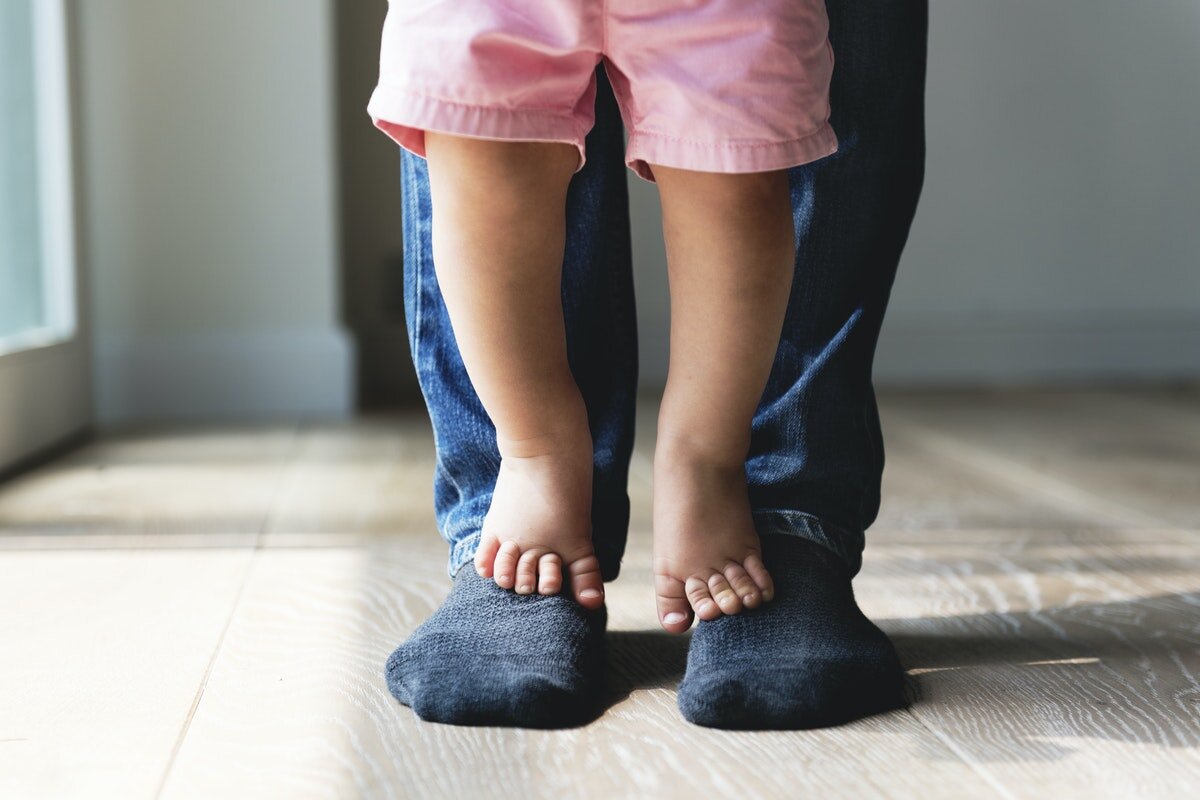Why Does My Child Toe Walk?
8 Ways to Improve your Child’s Walking Pattern at Home
Walking on the toes or the balls of the feet, also known as toe walking, is fairly common in children who are just beginning to walk. As they gain more practice with walking, most children will outgrow this toe walking pattern and begin to walk flat on their feet.
Between the ages of 2 and 3, a child should walk with a “heel-toe” pattern that reflects an adult walking pattern. However, there are many children that continue to walk on their toes beyond their toddler years. If your child is healthy and has been developing normally, persistent toe walking generally is not a cause for concern.
However, this walking pattern can lead to consequences later in childhood such as tight leg muscles, decreased balance, and decreased ability to keep up with same-aged peers. Read on to learn more about what causes toe walking and how to work on this at home.
What causes toe walking?
Many children will walk on their toes when they first begin to walk. This is because bearing weight through only the balls of the feet gives a child more sensory input and body awareness as they begin to navigate new terrain. Walking on the toes also helps to lock out the ankle joint, making it easier for a child to maintain their balance while they stand and walk. As a child’s balance and independence improves with walking, they should begin to “fine-tune” their walking pattern and lower down to their heels. With enough practice walking on flat feet, a child will develop sufficient ankle stability, leg strength, and overall balance and coordination to walk with a mature “heel-toe” walking pattern with limited tripping and falling.
However, many children find early on that they get around efficiently with a toe walking gait pattern, and eventually muscle memory takes over and they continue to toe walk as they age. This causes their calf muscles to grow stronger and tighter, making it easier and easier to walk on their toes (and more difficult to walk on flat feet). They do not develop adequate muscle strength and control in the appropriate muscle groups used for “heel-toe” walking. Furthermore, these children often do not learn how to sufficiently balance with their heels on the ground, making walking flat on their feet even more challenging. This becomes a vicious cycle as a child ages, making toe walking a very difficult habit to break.
As a child’s balance and independence improves with walking, they should begin to “fine-tune” their walking pattern and lower down to their heels. With enough practice walking on flat feet, a child will develop sufficient ankle stability, leg strength, and overall balance and coordination to walk with a mature “heel-toe” walking pattern with limited tripping and falling.
In addition to sheer muscle memory and habit, there are other factors that contribute to toe walking. For example, toe walking is frequently linked to difficulties with sensory processing in children. Some children are hypersensitive, and they may not like the feeling of different surfaces on their bare feet. This may cause them to rise up on their toes to avoid the feeling of a particular surface (or all surfaces) below their feet. For children who may be hyposensitive, or are considered “sensory seekers”, toe walking increases the force of impact felt during walking and motivates the child to continue walking this way.
There is also a theory that toe walking may be an element of a more global development delay. Although it is not clear what specifically causes the abnormality in the child’s gait pattern, research has shown that many children who toe walk also have speech delays and other developmental delays. Toe walking can also be caused by a number of underlying neuromuscular or musculoskeletal conditions, such as cerebral palsy and club foot.
Many children with a diagnosis of Autism Spectrum Disorder also walk exclusively on their toes, which is likely related to the sensory effects of toe walking discussed above. However, in most cases, toe walking in children has no known underlying pathological cause. Idiopathic Toe Walking (ITW) is therefore a diagnosis of exclusion, and it is important for a physician or physical therapist to rule out these other causes through an adequate history and physical exam.
Upon examination, a child with Idiopathic Toe Walking (ITW) will present with normal muscle tone, reflexes, sensation, and overall strength. The child may or may not have a passive limitation in ankle dorsiflexion (bringing toes up toward the shin). Depending on the severity of toe walking, a child may demonstrate muscle tightness and decreased strength in various muscle groups. ITW will have a bilateral and symmetrical presentation (toe walking on both feet), as opposed to some other neurologic conditions which may cause unilateral or asymmetric toe walking (toe walking only on one foot).
The child may toe walk only intermittently and correct their walking pattern if given reminders, or they may toe walk exclusively and have limited ability to correct their walking pattern.
A child who toe walks may frequently trip and fall when walking and running, and they may have difficulty with more challenging gross motor skills like jumping and going up or down the stairs.
Most children who present with ITW have a history of normal birth weight, walked on time (around 11-14 months), and began to toe walk immediately in their gait development.
Data shows that there is a higher incidence of toe walking in males as compared to females, and that a family history of toe walking often exists.
How do you treat toe walking?
The easiest way to treat toe walking is to prevent it at an early age. If you notice your child starting to stand or walk on toes around 10-12 months (or they continue to do this after they have been walking independently for a few months), you can provide gentle tactile cues such as downward pressure at the shoulders or hips to encourage weight bearing on the heels. You can also encourage activities that promote weight bearing through the heels, such as playing in a deep squat position.
Children who toe walk often take very short steps and keep their knees “locked out” in a straight position, so activities such as walking up the steps and stepping over small obstacles can encourage larger steps and more bending at the hips and knees. If your child is older than 2-years-old and has appropriate receptive language development, you can also use a verbal cue like “flat feet” to encourage a normal walking pattern. Younger children also often respond well to spending more time in stiff-soled shoes or boots that prevent them from walking on their toes.
If your toddler continues to toe walk despite your best efforts or you have an older child that has been toe walking for years, it is best to consult with your doctor and a physical therapist for a personalized treatment plan.
A physical therapist will help you and your child with the following:
Stretching tight muscles
Strengthening weak muscles in the legs and core
Improving weight-bearing on heels in various positions
Increasing standing balance on two-foot and on one-foot
Retraining walking patterns
Progressing gross motor skills with appropriate pattern
Obtaining foot orthotics or ankle braces to block toe walking pattern (if needed)
If you have not been able to consult with a physical therapist yet or you would like to try to work on toe walking at home, you can try the following exercises to promote a “heel-toe” walking pattern. It is also best to pair these exercises with FREQUENT reminders to walk with flat feet.
The Exercises
HAMSTRING STRETCH
Have your child lie on their back with their legs straight. Have them kick one leg up to a 90 degree angle. Support at the top of their thigh with one hand, then gently push at the back of their ankle in an attempt to straighten their leg. Hold for 30-60 seconds as tolerated on each leg. Your child should feel a “pulling” feeling in their hamstring muscle at the back of their thigh.
SQUATS
Have your child stand with their feet flat and positioned shoulder width apart. Have them complete a deep squat, keeping their toes and knees pointed straight ahead, and then return to standing. Repeat 10 times. You can place puzzle pieces on the floor for your child to pick up and place in a puzzle board to make it more fun. If your child struggles with a squat, kneel behind them and have them bring their bottom to your leg in order to give them more assistance.
STANDING ON ONE FOOT
Keeping their toes straight ahead, have your child stand on one foot for 5-10 seconds. If they are unable to do this independently, have them balance their foot on a ball. Complete on both feet. Increase the time as they are able. If this is too easy, you can try standing on one foot on an unstable surface, like a pillow.
WALKING ON A CURB OR BALANCE BEAM
Have your child walk slowly along a curb, wooden board, or even a line like it is a balance beam. Encourage them to take large steps and walk with a “heel-toe” pattern. Children who toe walk will attempt to rush through this activity, taking small steps, and shuffle feet. Hold their hand if they struggle with this activity.
HEEL WALKING (AKA “DUCK” WALKING)
Have your child walk forward 25-50 feet only bearing weight on their heels. Their toes should not touch the ground at all. You can pretend to be a duck and yell “quack quack!” to make it more fun.
HEEL CORD STRETCH
Have your child lie on their back with their leg straight. Use one of your hands to stabilize their heel and use your other hand to gently push their toes toward their shin. Hold for 30-60 seconds as tolerated on each leg. Your child should feel a “pulling” feeling in their calf muscle.
SEATED TOE TAPS
Have your child sit on a child-sized seat or stool. Their hips and knees should be at a 90 degree angle and their entire foot should be contacting the ground. Have your child “tap” their toes repetitively on the ground. You can place play-dough or another squishy surface under the balls of their feet to motivate them to tap up and down. Complete 10-20 times.
BRIDGES
Have your child lie on their back with their knees bent and their feet planted on the ground. Have them squeeze their bottom to lift their hips up into the air to make a “bridge”. Their shoulders, hips, and knees should be aligned in a diagonal line. Do not let them push up onto their tippy toes. Hold for 3-5 seconds and have them lower their bottom back to the ground. Repeat 10 times.
If your child is older than 2, struggles with these exercises, and continues to toe walk, it is best to consult with your doctor about a Physical Therapy referral. Make an appointment sooner if you notice that your child has extremely tight leg muscles, frequently trips and falls, or begins to toe walk unexpectedly (with no previous history of toe walking).
Keep in mind that toe walking can be challenging to address, and it may take months or even years for your child to re-train their body to walk exclusively with a heel-toe pattern.
Have questions or concerns? Get in touch with one of our therapists!








